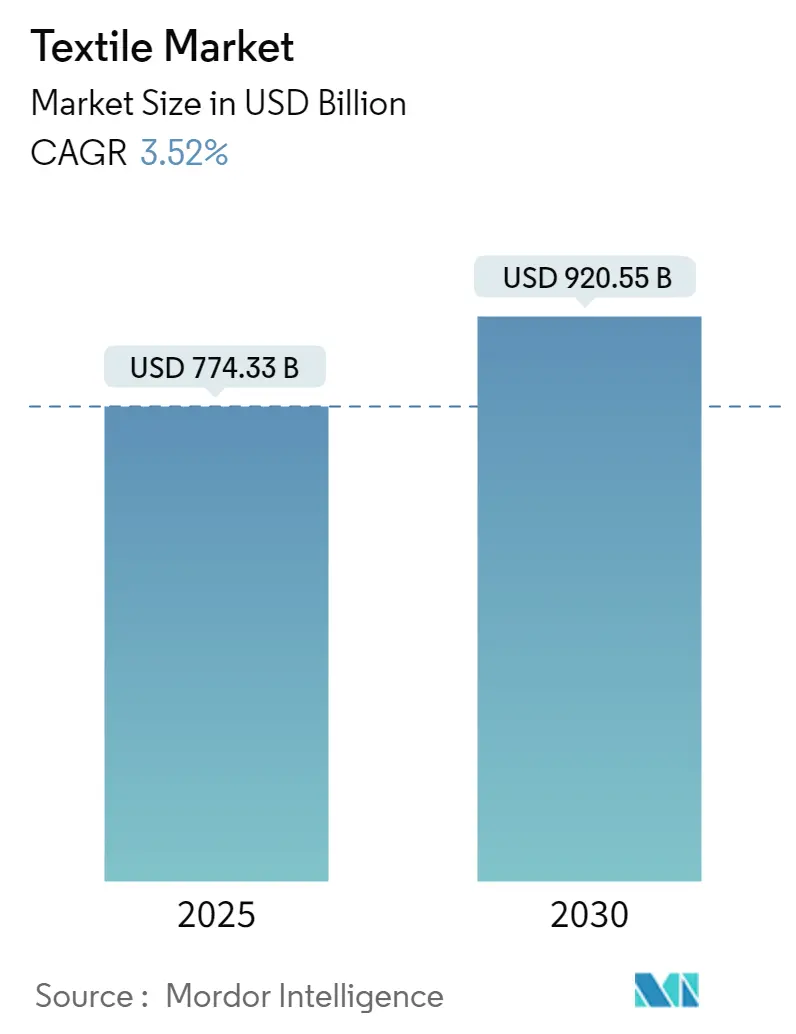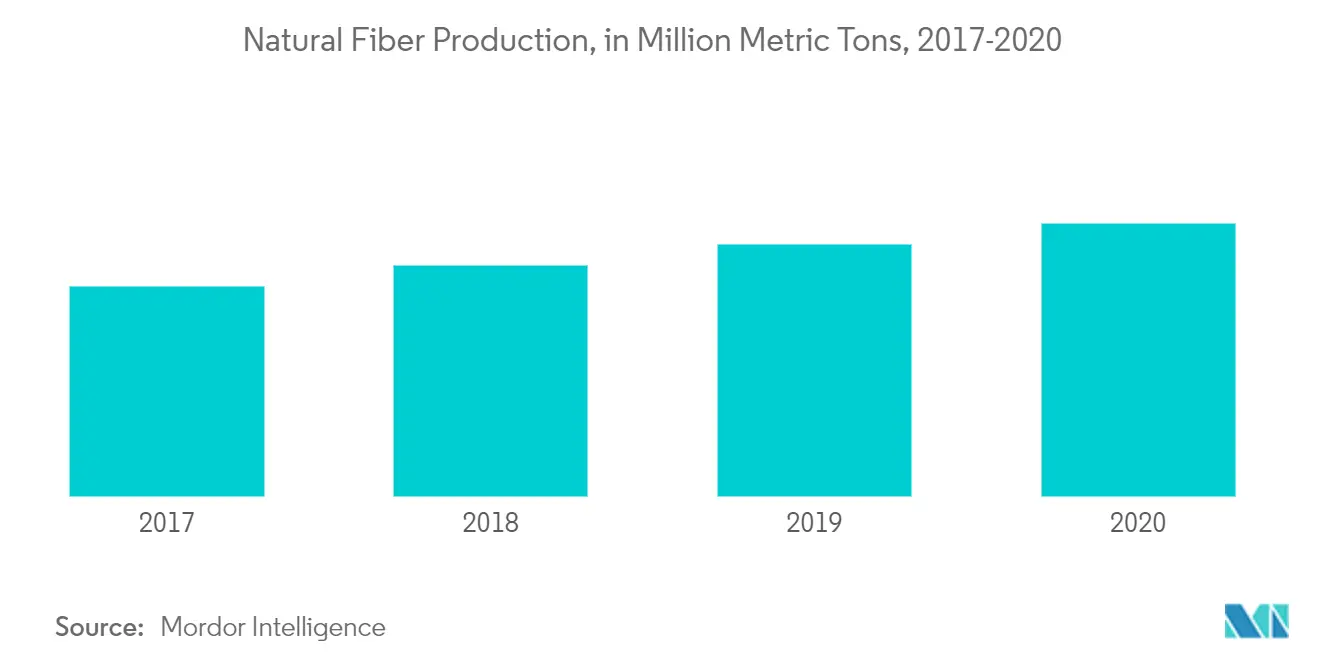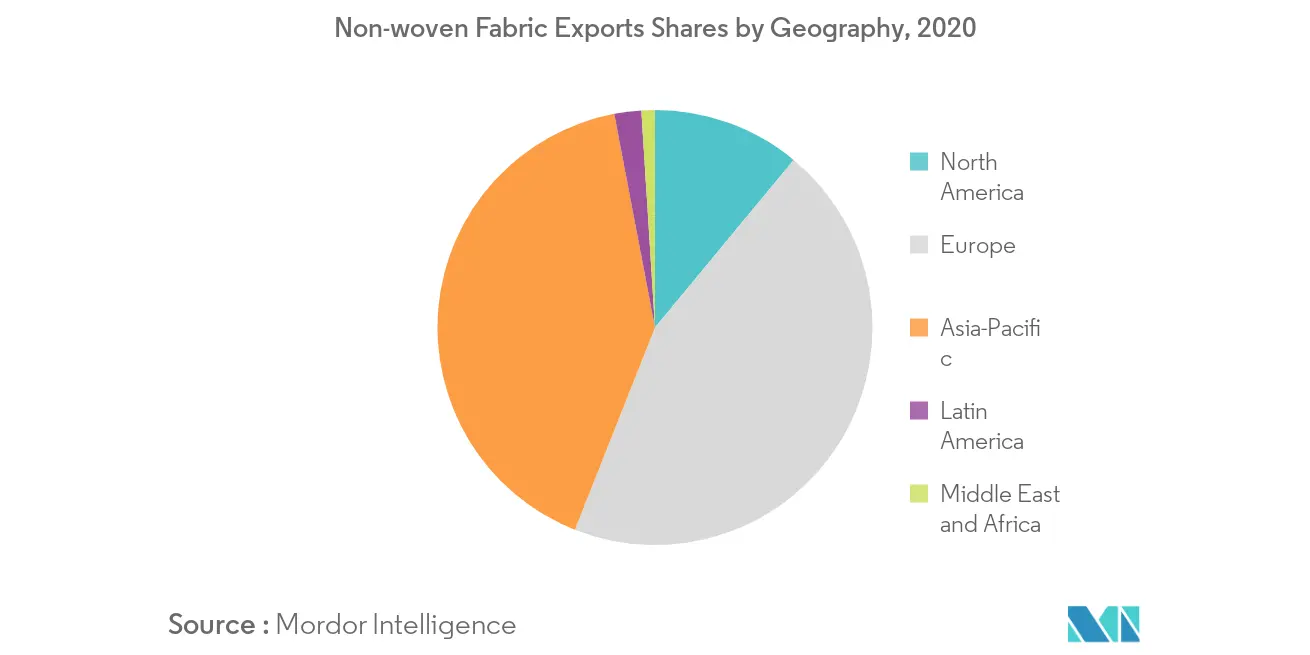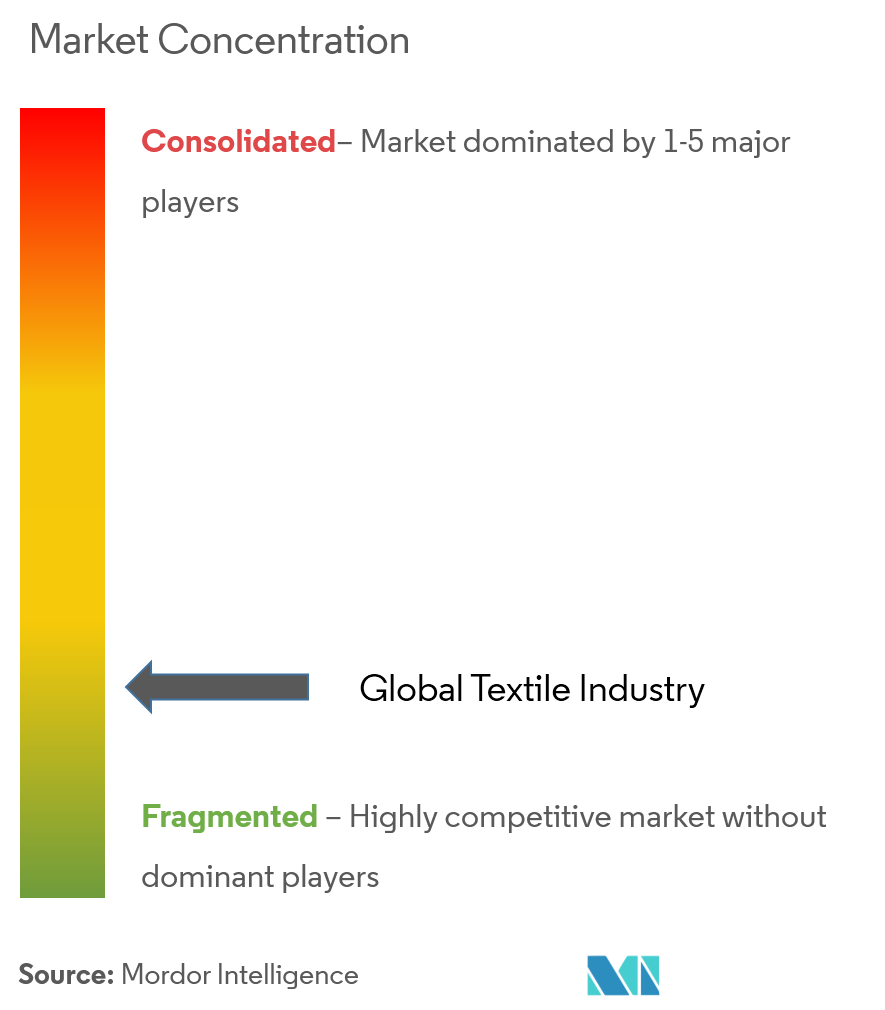Textile Market Analysis
The Textile Market size is estimated at USD 774.33 billion in 2025, and is expected to reach USD 920.55 billion by 2030, at a CAGR of 3.52% during the forecast period (2025-2030).
The COVID-19 pandemic has challenged the textile industry drastically in 2020. Asia, which is one of the largest markets for the textile industry in the world, has suffered from the prolonged lockdowns and restrictions in the majority of Asian countries along with the sudden drop in international demand for their products. The loss was particularly high in countries where the textile industry accounted for a larger share of the exports. According to the study by the International Labour Organization (ILO) the global textile trade collapsed during the first half of 2020. Also, exports to the major buying regions in the European Union, the United States, and Japan fell by around 70%. The industry also suffered several supply chain disruptions due to the shortages of cotton and other raw materials.
The textile industry is an ever-growing market, with key competitors being China, the European Union, the United States, and India. China is the world's leading producer and exporter of both raw textiles and garments. The United States is the leading producer and exporter of raw cotton, while also being the top importer of raw textiles and garments. The textile industry of the European Union comprises Germany, Spain, France, Italy, and Portugal at the forefront with a value of more than 1/5th of the global textile industry. India is the third-largest textile manufacturing industry and is responsible for more than 6% of the total textile production, globally. The rapid industrialization in the developed and developing countries and the evolving technology are helping the textile industry to have modern installations which are capable of high-efficient fabric production. These factors are helping the textile industry to record more revenues during the study period and are expected to help the industry further in the forecast period.
Textile Market Trends
Increasing Demand for Natural Fibers
Natural fiber composites are relatively lighter and have more strength than conventional fibers, and therefore, find extensive application in the automotive industry for interior and exterior applications. Natural fibers obtained from plants and animals include cotton, silk, linen, wool, hemp, jute, and cashmere. These fibers are widely used to manufacture garments, apparel, construction materials, medical dressings, and interiors of automobiles, among others. The abundance of natural fibers, especially cotton, in China, India, and the United States, is contributing significantly to the growth of the global textile market. Silk is used in upholstery and apparel, as it is available in both variations fine as well as coarse. Wool and jute are used as textile materials for their resilience, elasticity, and softness. The increasing consumption of natural fibers, such as cotton, silk, wool, and jute, will drive the global textile market during the forecast period.
Shifting Focus Toward Non-woven Fabrics
The increasing birth rate and aging population has contributed to the growing demand for hygiene products, such as baby diapers, sanitary napkins, and adult incontinence products, which, in turn, is expected to fuel the demand for non-woven fabrics. Nonwovens are used in road construction in the form of geotextiles to increase the durability of roads. Low maintenance costs associated with nonwovens are expected to fuel its demand in construction applications. The positive outlook of the automobile and transportation industry, globally, is further expected to propel growth for the non-woven fabric market over the next years. The automobile industry manufactures a large number of exterior and interior parts using non-woven fabrics owing to their durability. Rapid industrialization and recent innovations in the field of textile technology are other factors fueling demand for non-woven fabrics, globally.
Textile Industry Overview
The report covers the major players operating in the textile industry. In terms of market share, the companies in the global textile industry do not have a considerable amount of market share, as the market is highly competitive and fragmented.
Textile Market Leaders
-
Toray Industries Inc.
-
B.C. Corporation
-
Inditex SA
-
Shandong Weiqiao Pioneering Group Company Limited
-
Nisshinbo Holdings Inc.
- *Disclaimer: Major Players sorted in no particular order
Textile Market News
- In Feb 2021, The Indian Government has announced the setting up of seven mega textile parks in the next three years. The government has also decided to rationalize the duties on raw material inputs to manmade textiles by reducing the customs duty rate on caprolactam, nylon chips, and nylon fiber and yarn to 5 %.
- In Feb 2021, Paraguay's Ministry of Industry and Commerce announced that it will be investing USD 1.1 million in the manufacturing sector, mainly benefiting the clothing, textiles, and footwear industries, among other areas related to assembly operations.
Textile Industry Segmentation
The report aims to provide a detailed analysis of the global textile industry. It focuses on market dynamics, technological trends, and insights on the geographical segments and the process, material, and application types. Also, it analyses the major players and the competitive landscape in the global textile industry. The Textile Industry is Segmented by Application Type (Clothing, Industrial/Technical Applications, and Household Applications), By Material (Cotton, Jute, Silk, Synthetics, and Wool), by Process ( Woven and Non-woven), and by Geography (North America, Europe, Asia-Pacific, Latin America, and the Middle East and Africa). The report offers market size and forecasts for the textile industry in Value (USD billion) for all the above segments.
| Application | Clothing Application |
| Industrial/Technical Application | |
| Household Application | |
| Material | Cotton |
| Jute | |
| Silk | |
| Synthetics | |
| Wool | |
| Process | Woven |
| Non-woven | |
| Geography | North America |
| Europe | |
| Asia-Pacific | |
| Latin America | |
| Middle East & Africa |
Textile Market Research FAQs
How big is the Textile Market?
The Textile Market size is expected to reach USD 774.33 billion in 2025 and grow at a CAGR of 3.52% to reach USD 920.55 billion by 2030.
What is the current Textile Market size?
In 2025, the Textile Market size is expected to reach USD 774.33 billion.
Who are the key players in Textile Market?
Toray Industries Inc., B.C. Corporation, Inditex SA, Shandong Weiqiao Pioneering Group Company Limited and Nisshinbo Holdings Inc. are the major companies operating in the Textile Market.
Which is the fastest growing region in Textile Market?
North America is estimated to grow at the highest CAGR over the forecast period (2025-2030).
Which region has the biggest share in Textile Market?
In 2025, the Asia Pacific accounts for the largest market share in Textile Market.
What years does this Textile Market cover, and what was the market size in 2024?
In 2024, the Textile Market size was estimated at USD 747.07 billion. The report covers the Textile Market historical market size for years: 2019, 2020, 2021, 2022, 2023 and 2024. The report also forecasts the Textile Market size for years: 2025, 2026, 2027, 2028, 2029 and 2030.
Our Best Selling Reports
Textile Industry Report
The global textile market is experiencing significant growth, driven by the increasing demand for apparel influenced by the fashion industry and the expansion of e-commerce platforms. The market is segmented by application type, including clothing, industrial/technical, and household applications. It is further categorized by materials such as cotton, jute, silk, synthetics, and wool, with cotton leading due to its superior properties. The process segmentation includes woven and non-woven textiles, and the market is geographically segmented into North America, Europe, Asia-Pacific, Latin America, and the Middle East and Africa.
Industry analysis shows that the textile market is growing at a robust growth rate, driven by high consumer spending and the influence of social media on fashion trends. The market forecast indicates continued expansion, with significant contributions from both natural fibers and synthetic materials like polyester and nylon. The industry outlook reveals a shift towards sustainable products, with companies investing in eco-friendly manufacturing processes.
Market leaders are increasingly focusing on smart textiles, which incorporate materials that respond to environmental stimuli. This innovation is expected to boost the technical textiles segment. The industry reports provide a comprehensive market overview, including key statistics and market data, to offer a detailed understanding of the market trends and dynamics.
The market segmentation by application type shows that fashion remains a dominant segment, while the technical textiles segment is gaining traction due to advancements in smart textile technology. The market growth is supported by increasing market value and market predictions that highlight the potential for further industry expansion.
Industry research and industry information suggest that the market size and industry sales are expected to rise, driven by the demand for both natural and synthetic materials. The industry statistics indicate that the market structure is evolving, with a significant market review pointing towards the growing importance of sustainable and smart textiles.
The report example and report pdf provide detailed insights into the market trends, market overview, and market outlook. Research companies have highlighted the industry trends and market forecast, emphasizing the importance of market segmentation and the role of market leaders in driving market growth. The industry worth is projected to increase, reflecting the overall positive market trend.







